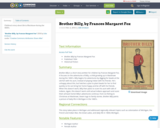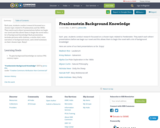
Children's story about life in Mackinaw during the 1800's.
- Subject:
- Arts and Humanities
- History
- Material Type:
- Primary Source
- Reading
- Date Added:
- 02/06/2018

Children's story about life in Mackinaw during the 1800's.

Each year, students conduct research focussed on a chosen topic related to Frankenstein and the 1800s. They watch each others' presentations before we begin our novel and this allows them to begin the novel with a lot of background knowledge!
Each presentation includes pictures with citations, a works cited, voice narration or background music, and a brief summary on their chosen topic. Enjoy!

What has been said of Moby-Dick—that it's the greatest novel no one ever reads—could just as well be said of any number of American "classics" like The Scarlet Letter, Uncle Tom's Cabin, or The Adventures of Huckleberry Finn. This course reconsiders a small number of nineteenth-century American novels by presenting each in a surprising context.

Imagine having to make every piece of clothing you wear. What tools would you use? How long would it take to make them? Where would you even start? Join Jefferson Patterson Park and Museum’s Curator Betty Seifert as she demonstrates the process of weaving with a combination of looms you can make at home up to larger vintage ones. Use to support Maryland standards for Math for Grade 4 or Maryland Social Studies frameworks for Grades 5 and 6. For Grade 4 Mathematics, Geometry, 4.G.A.3 have students plan their own simple weaving pattern with two colors and 4-10 warp/weft threads (so it can be planned on a grid from 4x4 up to 10x10). Before beginning their weave, student demonstrate whether their design is symmetrical using prior experience; students can weave in the classroom using a simple loom or with warp threads taped or velcroed at each end as seen in the video. For Grade 5 Social Studies Framework, Content Topic "Urbanization, Industrialization, and Immigration" have students weave using a simple loom or with threads taped/velcroed as seen in the video; allow them to experiment but have all students attempt to weave cotton duck fabric by passing two weft thread through the warp threads. Tightly woven fabric like this was a major product of Baltimore mills after the Civil War. Have students research housing and working in these mills. For Grade 6 Content Topic "Scarcity and Economic Decision-making" have students weave in the classroom with a simple loom or threads taped/velcored as seen in the video. Have students experiment with how long of time is needed to create a large enough cloth that might be useful then postulate how the development of different looms affected the scarcity of fabric and cloth and decreasing skill needed for weaving could have affected trading economies. If you evaluate or use this resource, please respond to this short (4 question) survey here bit.ly/3IhrtYs